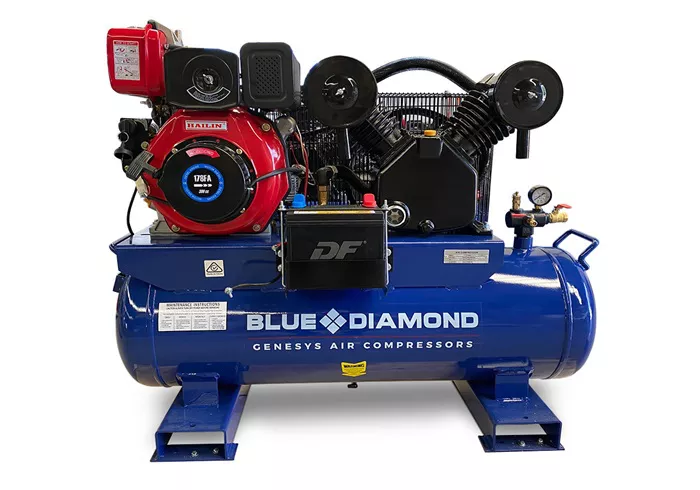When shopping for an air compressor, you’ll often come across the term “CFM.” But what does CFM mean, and why is it so important? CFM stands for Cubic Feet per Minute, and it’s a critical measurement that determines the performance and efficiency of an air compressor. Whether you’re a DIY enthusiast or a professional, understanding CFM is essential to choosing the right compressor for your needs.
In this guide, we’ll break down everything you need to know about CFM, including its definition, how it’s calculated, and why it matters. We’ll also explore the difference between CFM and SCFM, factors that affect CFM, and tips for selecting the right air compressor based on CFM requirements.
What is CFM?
CFM, or Cubic Feet per Minute, is a measurement of the volume of air that an air compressor can deliver at a specific pressure level. In simpler terms, it tells you how much air the compressor can push out in one minute.
For example, if an air compressor has a CFM rating of 5, it means the compressor can deliver 5 cubic feet of air every minute. This measurement is crucial because it determines whether the compressor can power your tools or equipment effectively.
Why is CFM Important in Air Compressors?
CFM is one of the most important specifications to consider when buying an air compressor.
Here’s why:
Tool Compatibility: Different tools require different CFM levels to operate efficiently. If your compressor doesn’t provide enough CFM, your tools won’t work properly.
Efficiency: A compressor with the right CFM rating ensures that your tools run smoothly without overworking the compressor.
Productivity: Insufficient CFM can lead to downtime, as the compressor may need to stop and build up pressure frequently.
Understanding CFM helps you choose a compressor that matches your needs, ensuring optimal performance and longevity.
CFM vs. SCFM: What’s the Difference?
While CFM is a common term, you may also encounter SCFM (Standard Cubic Feet per Minute).
Here’s how they differ:
CFM: Measures the volume of air flow at a specific pressure and temperature.
SCFM: Measures the volume of air flow under standardized conditions (typically 68°F, 0% humidity, and at sea level).
SCFM is often used to provide a more accurate comparison between compressors, as it accounts for variations in environmental conditions.
How to Calculate CFM for Your Needs
To determine the CFM requirements for your air compressor, follow these steps:
List Your Tools: Identify all the tools you plan to use with the compressor.
Check CFM Requirements: Look up the CFM rating for each tool (usually found in the user manual or product specifications).
Add Buffer: Add 30-50% to the total CFM to account for potential leaks or future tool additions.
For example, if you have two tools requiring 5 CFM and 7 CFM, respectively, your total CFM requirement would be 12 CFM. Adding a 30% buffer brings it to 15.6 CFM.
Factors That Affect CFM
Several factors can influence the CFM output of an air compressor:
Compressor Size: Larger compressors typically deliver higher CFM.
Motor Power: A more powerful motor can generate greater air flow.
Tank Size: While tank size doesn’t directly affect CFM, a larger tank can store more air, reducing the need for the compressor to run continuously.
Environmental Conditions: Altitude, temperature, and humidity can impact CFM performance.
How to Choose the Right Air Compressor Based on CFM
Selecting the right air compressor involves matching its CFM rating to your specific needs.
Here’s how:
Determine Your CFM Requirements: Calculate the total CFM needed for your tools, as explained earlier.
Check the Compressor’s CFM Rating: Ensure the compressor’s CFM rating meets or exceeds your requirements.
Consider Duty Cycle: If you’ll be using the compressor continuously, opt for one with a higher CFM and a 100% duty cycle.
Future-Proof Your Choice: Choose a compressor with slightly higher CFM to accommodate future tool additions.
Common Mistakes to Avoid When Evaluating CFM
When assessing CFM, avoid these common pitfalls:
Ignoring Tool Requirements: Failing to match the compressor’s CFM to your tools’ needs can lead to poor performance.
Overlooking SCFM: If the compressor’s CFM is measured under non-standard conditions, it may not reflect real-world performance.
Neglecting Air Leaks: Unaccounted air leaks can reduce the effective CFM available for your tools.
Tips for Maximizing CFM Efficiency
To get the most out of your air compressor’s CFM, follow these tips:
Regular Maintenance: Clean or replace air filters, check for leaks, and ensure proper lubrication.
Use Efficient Tools: Opt for tools with lower CFM requirements to reduce strain on the compressor.
Upgrade Your Compressor: If your current compressor can’t meet your CFM needs, consider upgrading to a more powerful model.
Conclusion
Understanding CFM is essential for choosing the right air compressor and ensuring it meets your needs. By calculating your CFM requirements, comparing CFM and SCFM, and considering factors that affect CFM, you can make an informed decision and avoid common mistakes. Whether you’re a DIYer or a professional, this guide will help you maximize the efficiency and performance of your air compressor.

